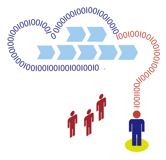How Supply Chain Integration Impacts Production Planning
Brian Hoey - November 05, 2020

 Pop quiz: As a production planner, what steps can you take to improve machine utilization by 20-40%? What to reduce setup time by 15-40%? Or unplanned emergency measure by more than 20%? If your answer was that you could achieve these benefits by optimizing production scheduling on a detailed level—you’re absolutely right. In an environment where you can visualize the entire process chain down to a parts level in order to create the optimal schedules to meet changing conditions and specifications, you can reduce idle time and waste. More than that, you can smooth out the entire production chain through smarter planning and replanning.
Pop quiz: As a production planner, what steps can you take to improve machine utilization by 20-40%? What to reduce setup time by 15-40%? Or unplanned emergency measure by more than 20%? If your answer was that you could achieve these benefits by optimizing production scheduling on a detailed level—you’re absolutely right. In an environment where you can visualize the entire process chain down to a parts level in order to create the optimal schedules to meet changing conditions and specifications, you can reduce idle time and waste. More than that, you can smooth out the entire production chain through smarter planning and replanning.
But how does this optimization actually occur? In other words, what can your average planner do to actually operationalize the kinds of improvements we alluded to above? Well, you need the right planning solution, and that planning solution needs to be connected to the right data sources. To make that possible, you need to start by focusing on supply chain integration.
What Is Supply Chain Integration?
Supply chain integration is the process of connecting every touchpoint across your entire supply chain with shared IT solutions and infrastructure. This can include both different elements of your own internal processes—such as production planning, inventory planning, and logistics planning—as well as points further up or downstream in the chain, e.g. raw material suppliers or logistics partners. The idea is to create enough visibility through carefully deployed solutions that you can gain a comprehensive overview of your entire value chain.
For our purposes, the important thing here is that your production planning software is implemented in such a way as to make it possible for production planners, for instance, to see how the current inventory situation lines with their needs for particular production runs. Or, by the same token, you might work to provide production planners with more insight into sales planning in order to better align demand and capacity.
To make this happen, you certainly don’t need a large, monolithic software solution (in fact, there are reasons why you should avoid such things), but you do need the software in use by each touchpoint to connect relatively seamlessly with the software in use at the other touchpoints. On the one hand, a set of modular solutions from a single provider could easily give you the flexibility you need to meet the divergent needs of different teams. On the other hand, if production planning adopts a shiny new planning solution while sales continues to rely on Excel spreadsheets, integration will remain a pipe dream.
The Top Challenges in Modern Production Planning
So, how does this all relate the optimization of production planning? On some level, most of the challenges that crop up in modern production planning come from missing or incomplete data—precisely what supply chain integration helps to fix. For instance, one of the most pressing high-level challenges that production planners deal with is matching supply to demand. Yes, this is something that happens at the level of S&OP (sales and operations planning), but it’s up to the production team to turn sales forecasts and goals into flexible planned production programs that can be adapted quickly as real demand emerges. A lot can go wrong in this process:
- A gap between sales reporting and production planning can result in machine idle time while planners wait to find out about demand conditions, or expensive special runs required to meet “unforeseen” demand that actually could have been identified early on.
- If production and inventory aren’t integrated, then you might be crafting lean, flexible production plans that simply can’t be carried out because you don’t have the necessary materials on hand when you need them. In these scenarios, it may be hard to say when the parts will be available again if your ordering workflows don’t have visibility into your suppliers, meaning that your schedules may be disrupted even further.
- In the event that data from the shop floor isn’t making it back to the planning control tower in a timely way, you run the risk of missing key indicators of a potential breakdown or disruption. In this way, you could easily overextend your capacity, resulting in late orders or costly premium freight runs.
In each of these situations, robust data integration with real-time updates from relevant touchpoints would have saved a lot of heartache. Planners in the modern production chain need to be proactive and adaptable, and in order to do so they need to have the right information at their fingertips.
How Integration Powers AI in the Planning Chain
Of course, it’s not just the information—it’s how you use it. Once you have a modicum of supply chain integration, it’s time to put that data to work. How? With advanced analytics integration and AI-powered planning capabilities. In this way, you can turn various data streams into improved demand forecasts and smart replannings as new conditions emerge. In this scenario, rather than noticing a potential disruption and working out a new plan by hand, your integrated planning solutions helps you visualize the relevant planning horizon and find the smartest way to sequence and schedule production runs based on your relevant parameters.
One of the most interesting technologies involved in these smart, integrated planning processes is the digital twin—a digital representation of your factory on which you can run AI-powered simulations. Using this technology, you can take different replanning scenarios and simulate their likely effects to determine which is the optimal choice from a cost and efficiency standpoint. Not only can these be useful planning aids, they can also power increased collaboration—since they’re highly visible representations of potential planning realities, and they can support multiple users creating simulations at once for the purposes of comparison. This is just one example of how analytics can guide human planners through a smarter planning process—one that can power the huge reductions in cost, setup time, and disruption we talked about above—and the basic building block of these workflows is supply chain integration.
LATEST POSTS
- Understand Why Production Planning Needs Specialized Solutions
- Understand Circular Economy in The Manufacturing Industry
- How Can Industry 4.0 IT Integration Be Achieved Smoothly?
- The Significance of Order Sequencing in Discrete Manufacturing
- How to improve your Supply Chain Management: The Power of Control Towers



